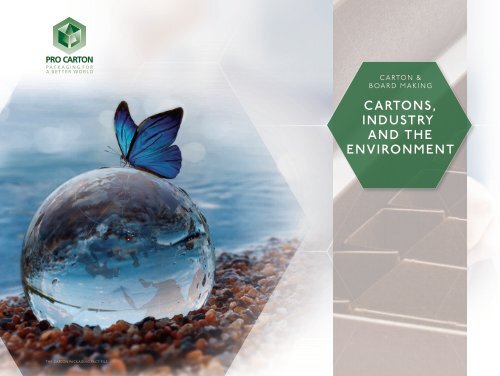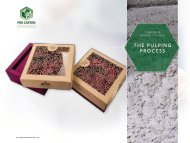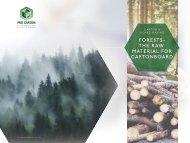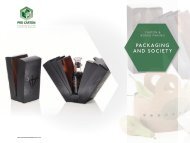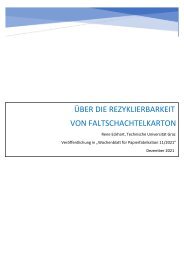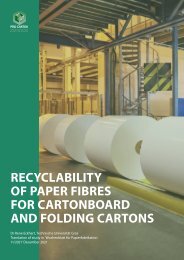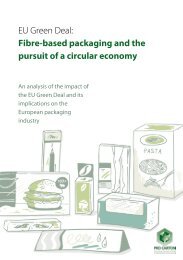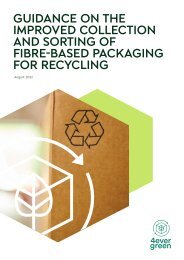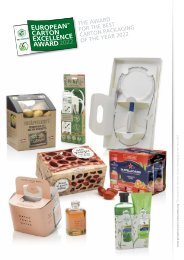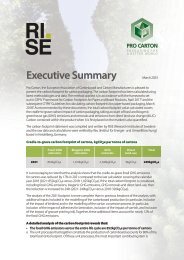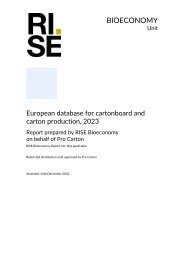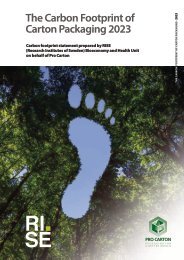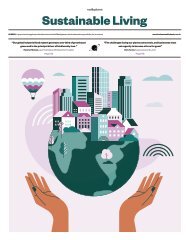Pro Carton Fact File – Module 2 – Cartons, Industry and the Environment
You also want an ePaper? Increase the reach of your titles
YUMPU automatically turns print PDFs into web optimized ePapers that Google loves.
CARTON &<br />
BOARD MAKING<br />
CARTONS,<br />
INDUSTRY<br />
AND THE<br />
ENVIRONMENT<br />
THE CARTON PACKAGING FACT FILE
FACTS ABOUT CARTONS<br />
WHAT ARE FOLDING CARTONS?<br />
Folding cartons are small to medium sized “cardboard boxes” made from cartonboard. They are referred to as<br />
folding cartons because <strong>the</strong>y are usually delivered to <strong>the</strong> packer in a flat form, ei<strong>the</strong>r as a side seam glued carton,<br />
which is folded flat, or as a flat piece of printed board cut around <strong>the</strong> perimeter to a carton profile. This feature<br />
provides a major space saving benefit in storage <strong>and</strong> transportation prior to packing.<br />
CARTON &<br />
BOARD MAKING<br />
CARTONS,<br />
INDUSTRY<br />
AND THE<br />
ENVIRONMENT<br />
The term folding is used to distinguish it from <strong>the</strong> rigid carton or box which is “set-up” by <strong>the</strong> manufacturer <strong>and</strong><br />
delivered in its three dimensional shape to <strong>the</strong> packer.<br />
WHAT TYPE OF PRODUCTS ARE PACKED IN CARTONS?<br />
<strong>Carton</strong>s are used to package a wide range of products including food stuffs such as cereals, rice, frozen <strong>and</strong> chilled<br />
foods, chocolate confectionery, cakes <strong>and</strong> biscuits, coffee, tea <strong>and</strong> o<strong>the</strong>r dry foods. They are also used to pack non<br />
food products such as pharmaceuticals, medical <strong>and</strong> healthcare products, perfumes, cosmetics, toiletries,<br />
photographic products, clothing, tobacco products, gifts <strong>and</strong> souvenirs, toys, games <strong>and</strong> leisure products,<br />
houseware, bulbs, spare parts, cups/tubs, electrical, engineering, gardening <strong>and</strong> DIY products.<br />
U K CARTO N S ECTO R - 2020 END USE MARKET SECTOR PROPORTION BY VALUE<br />
Food = 74.1%; Non-food = 25.9%<br />
Breakfast <strong>and</strong> cereal products <strong>–</strong> 10.1%<br />
Bakery <strong>–</strong> 7.0%<br />
Confectionery <strong>–</strong> 6.0%<br />
Dry beverages <strong>–</strong> 2.3%<br />
Chilled food <strong>–</strong> 16.6%<br />
Frozen food <strong>–</strong> 6.1%<br />
Wines <strong>and</strong> spirits <strong>–</strong> 6.7%<br />
Beer <strong>and</strong> soft drinks <strong>–</strong> 10.3%<br />
Food service <strong>and</strong> catering <strong>–</strong> 4.4%<br />
All o<strong>the</strong>r food <strong>–</strong> 4.6%<br />
Cigarettes, tobacco <strong>and</strong> accessories <strong>–</strong> 0.4%<br />
Cleaning <strong>and</strong> laundry products <strong>–</strong> 0.4%<br />
Beauty, cosmetics <strong>and</strong> oral care <strong>–</strong> 3.2%<br />
Personal hygiene <strong>–</strong> 0.8%<br />
Miscellaneous household products <strong>–</strong> 1.4%<br />
Paper, stationery <strong>and</strong> related goods <strong>–</strong> 0.3%<br />
Pharmaceuticals <strong>and</strong> medical products <strong>–</strong> 17.4%<br />
All o<strong>the</strong>r non-food <strong>–</strong> 3.1%<br />
Source: BPIF Research<br />
THE CARTON PACKAGING FACT FILE<br />
All contents copyright © BPIF 2017.
FACTS ABOUT CARTONS<br />
WHERE ARE PRODUCTS SOLD IN FOLDING CARTONS?<br />
Folding cartons are used for retail <strong>and</strong> <strong>the</strong> distribution of many different products around <strong>the</strong> world.<br />
<strong>Carton</strong>s play a vital role <strong>and</strong> are used across different industries to target markets <strong>and</strong> protect <strong>the</strong> product through<br />
distribution to <strong>the</strong> consumer. Commonly featured in <strong>the</strong> display of goods in supermarkets <strong>the</strong>y are increasingly used<br />
for mail order <strong>and</strong> at sporting events to distribute food <strong>and</strong> drink.<br />
CARTON &<br />
BOARD MAKING<br />
CARTONS,<br />
INDUSTRY<br />
AND THE<br />
ENVIRONMENT<br />
KEY STATISTICS FOR EUROPEAN PULP AND PAPER INDUSTRY<br />
In 2019 <strong>the</strong> European pulp <strong>and</strong> paper industry generated a total revenue of around 90 billion Euros among <strong>the</strong><br />
Confederation of European Paper Industries (Cepi) member countries.<br />
The total of pulp production worldwide in 2018 across all grades (chemical <strong>and</strong> mechanical pulp) amounted to<br />
178 million metric tonnes. (Statista 2018).<br />
<br />
THE CARTON PACKAGING FACT FILE<br />
All contents copyright © BPIF 2017.
FACTS ABOUT CARTONS<br />
WHAT DOES A TYPICAL PALLET OF CARTONBOARD LOOK LIKE?<br />
<strong>Carton</strong>board is ei<strong>the</strong>r purchased in sheets or reels depending on <strong>the</strong> requirements of <strong>the</strong> printing or conversion processes.<br />
The sheet or reel dimensions depends on <strong>the</strong> requirements of <strong>the</strong> printing press <strong>and</strong> <strong>the</strong> layout of <strong>the</strong> printed copy.<br />
HOW MANY CARTONS ARE OBTAINED FROM ONE TONNE OF CARTONBOARD?<br />
This mainly depends on <strong>the</strong> size of <strong>the</strong> carton <strong>and</strong> <strong>the</strong> amount of cut off waste during production. In <strong>the</strong> early design<br />
stage carton producers fit <strong>the</strong> cartons on <strong>the</strong> sheet to reduce waste to an absolute minimum. As an approximate example,<br />
one tonne of cartonboard would make around 11,000 large cereal cartons. How many also depends on <strong>the</strong> gramma ge of <strong>the</strong><br />
cartonboard used. This is carefully chosen to secure stiffness of <strong>the</strong> finished folding box. The sheets are customised to<br />
meet <strong>the</strong> requirement of converter's design <strong>and</strong> printing press. Each sheet is optimised to minimise cut off waste during<br />
<strong>the</strong> production process.<br />
In practice one tonne would be too large or heavy to h<strong>and</strong>le as a single unit. A medium sized pallet of board would have<br />
dimensions of, for example, 720 x 1020mm <strong>and</strong> would have a height of about 1350mm, of which 150mm would be <strong>the</strong> height<br />
of <strong>the</strong> wooden platform (pallet base) on which <strong>the</strong> sheets were stacked. The number of sheets would depend on <strong>the</strong><br />
thickness of <strong>the</strong> cartonboard. The weight of cartonboard on <strong>the</strong> pallet described could weigh from around 540kg to 680kg<br />
depending on <strong>the</strong> type of cartonboard.<br />
CARTON &<br />
BOARD MAKING<br />
CARTONS,<br />
INDUSTRY<br />
AND THE<br />
ENVIRONMENT<br />
THE CARTON PACKAGING FACT FILE<br />
All contents copyright © BPIF 2017.
FACTS ABOUT CARTONS<br />
CARTONS AND THE ENVIRONMENT<br />
All products have an impact on <strong>the</strong> environment <strong>and</strong> packaging is no exception. Packaging is discarded when <strong>the</strong> product<br />
contained has been used <strong>and</strong> its impact on <strong>the</strong> environment can sometimes be very visible.<br />
The main environmental issues surrounding carton packaging are:<br />
• Local sourcing of raw materials (90/98% from European forests).<br />
CARTON &<br />
BOARD MAKING<br />
CARTONS,<br />
INDUSTRY<br />
AND THE<br />
ENVIRONMENT<br />
• Sustainably managed forests.<br />
• Ensuring <strong>the</strong> industry continues to support <strong>the</strong> growth of healthy exp<strong>and</strong>ing forests.<br />
• Increase share of renewable energy during <strong>the</strong> production process.<br />
• Maintain awareness of environmental pressures <strong>and</strong> act responsibly to legislation changes.<br />
• Increasing prices of energy forces all mills to innovate <strong>and</strong> fur<strong>the</strong>r improve on energy/resource efficacy.<br />
The forests from which <strong>the</strong> wood is obtained for <strong>the</strong> paper <strong>and</strong> board industries are managed sustainably. <strong>Carton</strong>board<br />
<strong>and</strong> carton manufacturers seek to reduce environmental impact through <strong>the</strong>ir use <strong>and</strong> processing of resources. Major<br />
investments in manufacturing have ensured that all environmental legislation is complied with.<br />
CAN ENVIRONMENTAL IMPACT BE MEASURED?<br />
The amount of resources, <strong>the</strong> ways in which <strong>the</strong>y are used in <strong>the</strong> manufacture of a product <strong>and</strong> <strong>the</strong> residual<br />
materials generated during processing <strong>and</strong> at <strong>the</strong> end of <strong>the</strong> product’s life can all be measured by means of<br />
Life Cycle Analysis (LCA).<br />
Life Cycle Analysis (LCA) is defined as an audit of <strong>the</strong> resources used by a product, or process, <strong>and</strong> an assessment<br />
of <strong>the</strong> impact it has on <strong>the</strong> environment.<br />
THE CARTON PACKAGING FACT FILE<br />
All contents copyright © BPIF 2017.
FACTS ABOUT CARTONS<br />
Initially, <strong>the</strong> product or process Life Cycle Analysis (LCA) must be defined. It could be a complete ”cradle to grave”<br />
cycle starting with <strong>the</strong> extraction of <strong>the</strong> basic resources <strong>and</strong> ending with <strong>the</strong> disposal or recycling of residual<br />
material left when <strong>the</strong> product is discarded at <strong>the</strong> end of its useful life. It could also simply be a stage or process in<br />
<strong>the</strong> course of <strong>the</strong> life of a product.<br />
A definition of <strong>the</strong> goal <strong>and</strong> scope of a Life Cycle Analysis (LCA) is set <strong>and</strong> an audit is made of everything which is<br />
needed in <strong>the</strong> processing <strong>and</strong> use of <strong>the</strong> product, i.e. <strong>the</strong> “inputs”, such as raw materials, energy, water, chemicals<br />
etc., as well as everything leaving <strong>the</strong> cycle. i.e. <strong>the</strong> ”outputs”, including <strong>the</strong> product <strong>and</strong> all by-products generated<br />
by <strong>the</strong> process.<br />
The environmental impact of <strong>the</strong> product <strong>and</strong> all <strong>the</strong> by-products generated through emissions to air, to water or<br />
as solid waste is <strong>the</strong>n assessed. Many of <strong>the</strong> measurable features are already subject to environmental statutory<br />
controls in <strong>the</strong> manufacture of cartonboard <strong>and</strong> folding cartons.<br />
The fibres retain stored CO2 within <strong>the</strong> fibres during <strong>the</strong> recycling process helping to offset <strong>the</strong> carbon footprint<br />
<strong>and</strong> help minimise <strong>the</strong> environmental impact. Laboratory tests prove that after 25 cycles of use <strong>the</strong> quality of<br />
cartonboard fibres is still good for recycling. Each carton that consumers <strong>and</strong> retailers make available for recycling<br />
is a very valuable resource for new carton packaging.<br />
CARTON &<br />
BOARD MAKING<br />
CARTONS,<br />
INDUSTRY<br />
AND THE<br />
ENVIRONMENT<br />
IS THERE A STANDARD LCA METHODOLOGY?<br />
It is most important that <strong>the</strong> results <strong>and</strong> conclusions from an LCA are carried out in accordance with internationally<br />
agreed methods. St<strong>and</strong>ards have been issued for LCA’s by <strong>the</strong> International Organisation for St<strong>and</strong>ardisation (ISO),<br />
following liaison between <strong>the</strong> Society of <strong>Environment</strong>al Toxicology <strong>and</strong> Chemistry (SETAC) <strong>and</strong> <strong>the</strong> European<br />
Commission. ISO 1440 is a LCA st<strong>and</strong>ard <strong>and</strong> should be used as a starting point for LCA methodology.<br />
CARTONBOARD<br />
LIFE CYCLE<br />
THE CARTON PACKAGING FACT FILE<br />
All contents copyright © BPIF 2017.
FACTS ABOUT CARTONS<br />
ARE CARTONS ECO-FRIENDLY?<br />
Yes, cartonboard is made from wood, <strong>the</strong> only naturally renewable packaging raw material. The wood used to make<br />
cartonboard comes from sustainably managed forests, 90/98% from European forests. These - <strong>and</strong> all <strong>the</strong> forests in<br />
<strong>the</strong> world are essential for <strong>the</strong> regional <strong>and</strong> global environment.<br />
Fur<strong>the</strong>rmore, <strong>the</strong> energy used to process <strong>the</strong> wood in <strong>the</strong> paper <strong>and</strong> board industry is often derived from <strong>the</strong><br />
non-cellulose constituents of <strong>the</strong> wood <strong>and</strong> is also naturally renewable. Emission risks in processing <strong>and</strong> use have<br />
been significantly reduced to low <strong>and</strong> benign levels.<br />
Europe is <strong>the</strong> world leader when it comes to recycling paper <strong>and</strong> board - 82.4% is recycled. (Eurostat 2018). This<br />
means that more recycled fibres are being used as a raw material by Europe's paper <strong>and</strong> board producers. In 2018<br />
paper <strong>and</strong> board recycling provided 53% of <strong>the</strong> fibre to manufacture new material compared to 47% of virgin fibre.<br />
(Cepi Key statistics 2018). The expectation is that <strong>the</strong>re will be an equal share of <strong>the</strong>se two commodities by 2023.<br />
The recent European Consumer Packaging Perceptions Study shows <strong>the</strong>re is now a 90% preference for cartonboard<br />
ra<strong>the</strong>r than plastic material. (<strong>Pro</strong> <strong>Carton</strong> 2021 European Consumer Packaging Perceptions Study).<br />
CARTON &<br />
BOARD<br />
CARTON<br />
MAKING<br />
&<br />
BOARD MAKING<br />
CARTONS,<br />
INDUSTRY<br />
AND THE<br />
ENVIRONMENT<br />
CONSUMERS REGARD CARTONS AS ECO-FRIENDLY<br />
Market research carried out by <strong>Pro</strong> <strong>Carton</strong> for <strong>the</strong> 2021 European Consumer Packaging Perceptions Study showed<br />
that consumers consider cartons to be <strong>the</strong> most environmentally friendly packaging option.<br />
This is because cartons are made from a naturally renewable resource. Consumers underst<strong>and</strong> <strong>and</strong> trust in <strong>the</strong> given<br />
recycling infrastructure <strong>and</strong> truly recognise circularity of carton packaging material.<br />
WHICH PACKAGING DO YOU THINK IS THE MOST ENVIRONMENTALLY FRIENDLY?<br />
Plastic<br />
<strong>Carton</strong>s<br />
Tin<br />
Glass<br />
None<br />
Don’t know<br />
Source: <strong>Pro</strong> <strong>Carton</strong> 0% 10% 20% 30% 40% 50%<br />
THE CARTON PACKAGING FACT FILE<br />
All contents copyright © BPIF 2017.
FACTS ABOUT CARTONS<br />
4evergreen, is a cross-industry alliance with <strong>the</strong> goal of optimising fibre-based packaging circularity <strong>and</strong> climate<br />
performance. More than 90 stakeholders from <strong>the</strong> entire value chain work toge<strong>the</strong>r to fur<strong>the</strong>r improve <strong>the</strong><br />
environmental performance of fibre-based packaging.<br />
4evergreen‘s aim is to raise <strong>the</strong> overall recycling rate of fibre-based packaging to 90% by 2030.<br />
To achieve this goal four targets have been set:<br />
• The industry adopts 4evergreen’s recyclability evaluation protocol <strong>–</strong> circularity by design.<br />
• Separate collection schemes are available for all fibre-based packaging types.<br />
• All paper for recycling is sorted according to different paper <strong>and</strong> board categories specified in <strong>the</strong> EN643 st<strong>and</strong>ard.<br />
• Collected fibre-based packaging, specifically from household, out-of-home <strong>and</strong> on-<strong>the</strong>-go consumption,<br />
is generally recycled.<br />
CARTON &<br />
BOARD MAKING<br />
CARTONS,<br />
INDUSTRY<br />
AND THE<br />
ENVIRONMENT<br />
THE CARTON PACKAGING FACT FILE<br />
All contents copyright © BPIF 2017.
KEY FACTS<br />
In Europe <strong>the</strong> manufacture of cartonboard is expected to increase to 9.5 billion metric tonnes<br />
by 2021. An estimated increase of 1.3% over <strong>the</strong> previous year <strong>and</strong> represents <strong>the</strong> output value<br />
of companies belonging to ECMA, The European <strong>Carton</strong> Makers Association.<br />
Market research shows that cartons are perceived as being <strong>the</strong> most environmentally friendly<br />
packaging material compared with plastics, tins <strong>and</strong> glass.<br />
The direct CO2 emissions of <strong>the</strong> European pulp <strong>and</strong> paper industry reduced by 25% between<br />
2005 <strong>and</strong> 2017 (CEPI Key Statistics 2017).<br />
<strong>Carton</strong>board is <strong>the</strong> most sustainable packaging material. It is made from trees grown in<br />
sustainably managed forests. It is renewable, recyclable <strong>and</strong> biodegradable. The perfect<br />
example of <strong>the</strong> circular economy.<br />
CARTON &<br />
BOARD MAKING<br />
CARTONS,<br />
INDUSTRY<br />
AND THE<br />
ENVIRONMENT<br />
THE CARTON PACKAGING FACT FILE<br />
All contents copyright © BPIF 2017.
ACKNOWLEDGEMENT<br />
<strong>Pro</strong> <strong>Carton</strong> would like to thank <strong>the</strong> following companies for contributing both information <strong>and</strong><br />
images to support <strong>the</strong> creation of <strong>the</strong>se <strong>Fact</strong> <strong>File</strong>s:<br />
CARTON &<br />
BOARD MAKING<br />
CARTONS,<br />
INDUSTRY<br />
AND THE<br />
ENVIRONMENT<br />
THE CARTON PACKAGING FACT FILE<br />
ALL CONTENTS © PRO CARTON & UKFCA LTD. ALL STATISTICS CORRECT UP TO 2021<br />
All contents WWW.PROCARTON.COM<br />
copyright © BPIF 2017.


